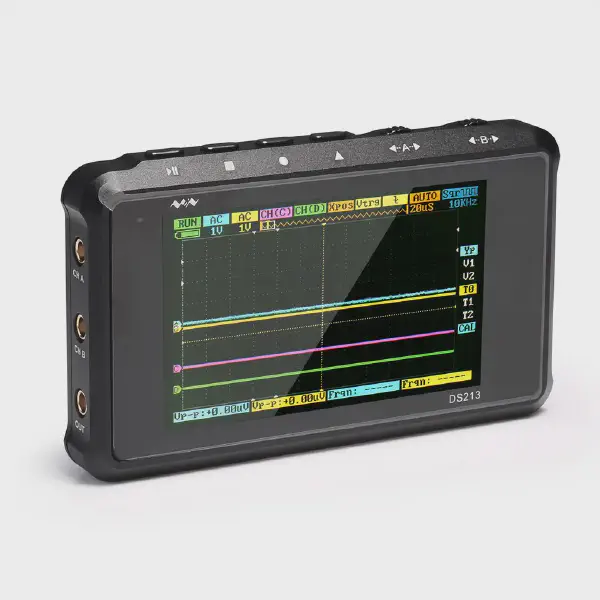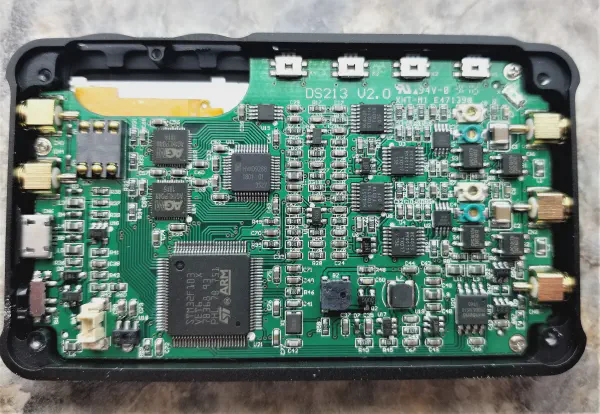
The DS213
DS213 15MHz 4 Channel Scope
The DS213 is a very small handheld scope from Miniware. Its marketed as capable of up to 15MHz on two of the channels, and 1MHz on the other channels. However, at 15MHz input, it is starting to round off and struggle with the signals fairly badly. At 8MHz (somewhat common for SPI), the SPI signals are easily understandable, and I generally use the two high speed signals for CLK and the signal I care most about from MISO and MOSI. The CS line is often completely fine on the lower speed 1MHz channels as it does not toggle often.
My absolute favourite aspect of this new design, is the user interface. On the older miniture oscilloscopes from Miniware, the devices used a typical oscilloscope style interface, with a menu on the right hand side of the screen. This is a very faimilar interface, that most users can pick up fairly quickly. But they do not allow hiding of the menu typically, which can cut into the screen real estate.
Navigating through the menus is a different to typical devices, as two encoder wheels are used to navigate through options (one controls the menu, and one selects the menu item). Pressing on the wheels then allows the highlighted item to be selected and adjusted.
The DS213 removes this entire menu system, for an unconventional, but quite useful, adjustment system instead. All of the menus are replaced by using the status icons instead. Using one of the encoder wheels, a small blinking highlight moves around all of the icons on the edges of the screen. Rotating the wheel clockwise, moves the highlight clockwise and vise versa. Once you have the option you would like to adjust selected, rotating the other encoder, will then adjust that value. For most options this will cycle through all of the available options. For some options, such as the trigger, pressing the K2 button at the top of the unit will change which channel is associated with the option. This works well for selecting which channels vertical position you would like to adjust (Highlight Ypos, and then select channel and scroll).
There is an extra menu on the device, that can be bought up with the K3 key, this allows changing settings for the device, such as the time until the backlight turns off. As well as storing screen captures from the device (or CSV recordings) to the internal 8MB storage drive.
The device’s firmware has had its own share of small glitches. In the first version of the firmware that was released, moving the trigger point to the left hand side of the screen would result in glitched data appearing between the left hand edge and the trigger point. In the latest published firmware this glitch has been mostly fixed. I have, however, struggled to have the unit save settings sometimes.
When first turning on the unit, it defaults to fairly annoying settings, with all of the channels on. You can turn these off by scrolling to the AC/DC selection for the channel and changing this to “-” which turns off the channel entirely. It appears that saving the settings in the device menu appears to usually save these settings as well. Though I have had these reset once or twice.
The device is firmware upgradable, which is a nice feature if these bugs should be fixed. (No I dont currently plan to make a new firmware for this device, but if you had ideas…). Also, SWD debugging is enabled, and it is also exposed on the USB port. Same as the TS80 and many of the newer Miniware products.
In this configuration, the USB D+/D- are also connected to the SWDIO/SWCLK pins in paralell, so using the debugger will also work. Note that this does prevent using the debugging while connecting to a computer via USB.
Inside

The DS213 Main board - https://www.cnx-software.com
Looking that the internal PCB, the main processor is an F103 from STM, which is impressive to have this level of performance from a low end MCU.
I believe the AGM IC’s are the sampling ADC’s used for the main signal capture.
Also visible is the dense analog frontend used for channels A & B to ensure high quality signal captures.
What the device is not good for
- Do not expect protocol decoding, or fancy features
- The waveform generation is somewhat limited in its features
- Using all 4 channels starts to impact on the update rate of the display
- Ultra high accuracy - Its only an 8Bit input stage
What the device is good for
- Portable diagnostics (is this device talking or not)
- Analog (aka slower) measurements, the device works really well for inspecting analog measurement stages
- General poking around circuits to understand whats happening
- Keeping your workbench less cluttered
What I normally use the device for
One of the lesser talked about features, is just for viewing and monitoring an activity indication. When I’ve been profiling embedded devices, I often setup a GPIO to indicate if the device is in a low power sleep or not. Having a small device on your desk, showing a live trace of this allows for instant feedback on if your change improved the devices power modes. Running the device off a USB port keeps it charged, and allows for it to be used as a continious visualisation of the state of the system.
I have replaced my normal digital oscilloscope with this unit now, as it does the features I actually use, in a much smaller package. Having a signal generator built in is handy, but I rarely use the feature. Though, I have used it to bring up a circuit when I was out of stock of the crystal required. I have also used it to allow profiling the ADC capture on a microcontroller, feeding in a square wave at a similar rate to the systems maximum input allowed for easy profiling to ensure software changes did not impact performance at the top end.
I strongly suggest picking up the 0.1" header connection cable for the unit. I’m not 100% sure of its maximum frequency range, but it comes in handy to clip into existing test points, or event just as an easy to clip grounding lead for the unit.
The included probe performs well up to the units maximum input, although the lack of adjustment on my unit prevents fine tuning the response.
There are adjustment potentiometers inside of the scope front end that would allow tuning its response further, however, I have not dared to mess with these significantly.
Summary
I personally find this to be a very useful tool for the bench. It follows me around in my tool back along with my Saleae. I often pull it out first to check what im poking and if its worth justifying poking into with more advanced tools, or if the issue lies elsewhere.
I did find the software interface to be mildly confusing at first, however, after getting used to the style of navigation, adjustments can be made fairly quickly without hunting through menus (everything is there, just have to rotate around to it).